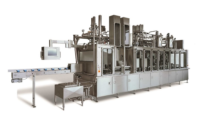Machinery Technology: Dairy filling & closing
Filling and closing the dairy packaging industry
These machines must be fast, sanitary and flexible.

Designed and manufactured in accordance with international hygienic standards, the OYSTAR Hassia SAS 20/30 Aseptic Pouch Form-Fill-Seal Machine can operate as many as eight lanes.

Running at a speed of approximately seven packs per second, the Tetra Pak A3/Speed has tripled Mengniu’s line productivity.

The A7 boats maximum on-site flexibility for immediate response to market changes for fresh dairy products, like yogurt.



Late last year Tetra Pak (tetrapak.com) released its seventh Dairy Index. The report reveals that global demand for milk is set to surge by 36% in the next decade, largely due to population growth, rising prosperity and urbanization in Africa, Asia and Latin America. However, milk supply and demand is imbalanced across the world – rising demand in emerging dairy markets is unlikely to be fulfilled by locally produced raw milk, while developed dairy markets producing a milk surplus face the challenges of competing for the export and responding to falling domestic consumption.
The report highlights the opportunities and challenges posed by rising global demand, which is set to overtake the available supply over the next decade.
“The predicted surge in global demand offers a huge opportunity for dairy companies in developed markets to export powder and ambient liquid dairy products to growing economies. However, to ensure long-term success, these producers need to balance the ‘quick wins’ of export against the requirement to continue to grow their domestic markets,” says Dennis Jönsson, president and CEO of Tetra Pak Group.
From opportunity grows innovation and filling machinery designed for the dairy industry not only strives for such innovation, but also works to meet other criteria. These machines must meet sanitation restrictions with a flexible design to meet changing consumer needs and wants.
Tetra Pak’s A3/Speed filling machine for Tetra Prisma Aseptic portion packs has been successfully deployed with its first customer, Mengniu, a leading Chinese dairy company. Running at a speed of approximately seven packs per second, the Tetra Pak A3/Speed has tripled Mengniu’s line productivity. According to Tetra Pak, it is one of the world’s fastest filling machines for carton packages.
Part of Mengniu’s decision to purchase the machine was in response to the rising demand for its premium flavored milk, Latte. The company was running two filling machines at full capacity at the time, delivering an annual output of 94 million packs, but was still not able to keep up with demand.
“Within ten months of installing the first Tetra Pak A3/Speed, 100 million packages had been produced on a single line, and we were able to reduce the overall operational cost for Latte by 20% in comparison with low speed filling machines…,” says Gao Jianjun, factory manager of Mengniu Dairy Plant in Ma’anshan City.
Another machine is packaging aseptic dairy products at high speeds, as many as 24,000 stick packs per hour. Aseptic stick packs are commonly used for dairy products such as coffee creamers, certain desserts and cream cheese. Aseptic stick packs offer extended shelf life and allow for the use of fewer preservatives in the product. For the filling of these stick pouches, OYSTAR USA (oyster-group.com) introduces the OYSTAR Hassia SAS 20/30 Aseptic Pouch FFS Machine. The machine offers product-specific filling systems with high filling accuracy and is designed and manufactured in accordance with international hygienic standards. Also, it can operate as many as eight lanes. After manufacturing the aseptic stick packs by sterilizing foil on all sides, the machine then fills and seals these pouches under aseptic conditions in a sterile tunnel. Through this process of active packaging material sterilization, a bacteria reduction >log5 is achieved, which results in extended shelf life, even outside the cooling chain.
For maximum flexibility in desserts and fresh dairy, Arcil (arcil.com) introduces the A7, a new generation FFS machine. The A7 was designed to retain the best of Arcil’s efficiency and hygiene in a modular and flexible FFS machine with fully mastered design. The aim was to offer a highly competitive state-of-the-art machine, while reducing the delivery lead time that applies to the tailor-made packaging lines usually designed by Arcil.
The company worked to create the equipment while adhering to two guidelines that drove the innovation: Customer insight and design to cost. The A7 boasts maximum on-site flexibility for immediate response to market changes. And in today’s packaging sphere, flexibility is king as consumers are used to more variety and more packaging sizes to meet their needs. The A7 has been designed to allow on-site capacity and cup size adaptation, so that manufacturers can react quickly to new markets requirements and reduce the global downtime of their lines.
Dairy filling machinery must meet stringent demands to ensure the product being filled is safe. These machines must move quickly with maximum flexibility and with sanitation standards in mind.
SIDE BAR:
Top considerations when choosing a form, fill seal machine over a fill-seal machine for use in the dairy market
Contributed by Arnold Lawner, vice president of sales for OYSTAR USA.
Advantages of form-fill-seal vs. fill-seal
1. Important savings in packaging materials (20% to 60%)
2. Minimum logistics (stock of a few rolls of materials vs. multiple boxes of cups, less trucking, less warehouse space required, less manpower to load and unload)
3. Cleaning of the cup unnecessary
4. Mold ownership = independence from cup suppliers
5. Complaint ratio lower with no chance of foreign material in cup
6. Multipacks of 2, 4, 6, etc. cups. Folding carton or shrink over-wrapping not necessary
7. Large printing area on the lid
8. Easy and quick change of the labels according to the flavor
Looking for a reprint of this article?
From high-res PDFs to custom plaques, order your copy today!










